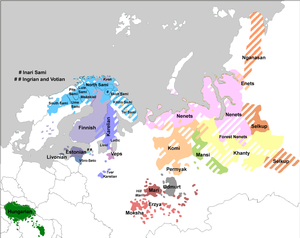lingvo.wikisort.org - Language
Seto (seto kiil´;[2] Estonian: setu keel) is a dialect of Estonian or a separate language spoken by 12,549 people.[1] It is sometimes identified as a dialect of Võro, or the two are described as one language, Võro-Seto. Setos (setokõsõq) mostly inhabit the area near Estonia's southeastern border with Russia in Setomaa, and are primarily Eastern Orthodox, while Võros (võrokõsõq) are traditionally Lutherans and live in historical Võru County.
This article includes a list of general references, but it lacks sufficient corresponding inline citations. (January 2022) |
| Seto | |
|---|---|
| seto kiil´ | |
| Native to | Estonia |
| Region | Southern Estonia |
| Ethnicity | Setos |
Native speakers | 13,000 (2011 census)[1] |
Language family | Uralic
|
| Language codes | |
| ISO 639-3 | – |
| Glottolog | seto1241 |


Language sample
This section does not cite any sources. (July 2022) |
Article 1 of the Universal Declaration of Human Rights:
- Seto: Kõik inemiseq sünnüseq vapost ja ütesugumaidsist uma avvo ja õiguisi poolõst. Näile om annõt mudsu ja süämetun'stus ja nä piät ütstõõsõga vele muudu läbi kjauma.
- Võro: Kõik inemiseq sünnüseq vapos ja ütesugumaidsis uma avvo ja õiguisi poolõst. Näile om annõt mudsu ja süämetunnistus ja nä piät ütstõõsõga vele muudu läbi käümä.
- Estonian: Kõik inimesed sünnivad vabadena ja võrdsetena oma väärikuselt ja õigustelt. Neile on antud mõistus ja südametunnistus ja nende suhtumist üksteisesse peab kandma vendluse vaim.
- Finnish: Kaikki ihmiset syntyvät vapaina ja tasavertaisina arvoltaan ja oikeuksiltaan. Heille on annettu järki ja omatunto, ja heidän on toimittava toisiaan kohtaan veljeyden hengessä.
- English: All human beings are born free and equal in dignity and rights. They are endowed with reason and conscience and should act towards one another in a spirit of brotherhood.
References
- Statistics Estonia
- Seto language @ google scholar
- Alekseev, F. (2016) Opyt polevogo issledovanija jazyka seto. Finno-ugorskij mir. No. 3. 14–17.
- Eichenbaum, K.; Pajusalu, K. (2001): Setode ja võrokeste keelehoiakutest ja identiteedist. – Keel ja Kirjandus nr 7, lk. 483–489.
- Eller, K. (1999): Võro-Seto language. Võro Instituut'. Võro.
На других языках
[de] Seto (Sprache)
Seto oder Setu (seto kiil´) ist eine ostseefinnische Sprachvarietät, die an der südlichen estnisch-russischen Grenze gesprochen wird und oft als ein Dialekt des Estnischen betrachtet wird. Sie wird von rund 5000 Menschen überwiegend in Südostestland und im unmittelbar angrenzenden Teil der Oblast Pskow, im sogenannten Land der Seto (setu Setomaa, estnisch Setumaa) gesprochen. Ein Teil der Sprecher identifiziert sich als Setukesen, einer besonderen sprachlich-kulturellen Gemeinschaft, deren traditionelle Religion das orthodoxe Christentum war.- [en] Seto dialect
[es] Idioma seto
El idioma seto (seto kiil´) es una lengua del grupo fino-báltico de la familia de lenguas fino-ugrias, hablada por unas 5.000 personas de la etnia seto, que habitan en su gran mayoría en los condados estonios de Põlvamaa y Võrumaa y en el óblast de Pskov en Rusia.[it] Dialetto seto
Il dialetto seto[1] o setu è una lingua baltofinnica parlata in Estonia.[2][ru] Сету (диалект)
Се́ту (самоназв. seto kiil, эст. setu keel) — язык одноимённого народа, проживающего в юго-восточной Эстонии и в Печорском районе Псковской области России. Относится к прибалтийско-финской подгруппе.Текст в блоке "Читать" взят с сайта "Википедия" и доступен по лицензии Creative Commons Attribution-ShareAlike; в отдельных случаях могут действовать дополнительные условия.
Другой контент может иметь иную лицензию. Перед использованием материалов сайта WikiSort.org внимательно изучите правила лицензирования конкретных элементов наполнения сайта.
Другой контент может иметь иную лицензию. Перед использованием материалов сайта WikiSort.org внимательно изучите правила лицензирования конкретных элементов наполнения сайта.
2019-2025
WikiSort.org - проект по пересортировке и дополнению контента Википедии
WikiSort.org - проект по пересортировке и дополнению контента Википедии
